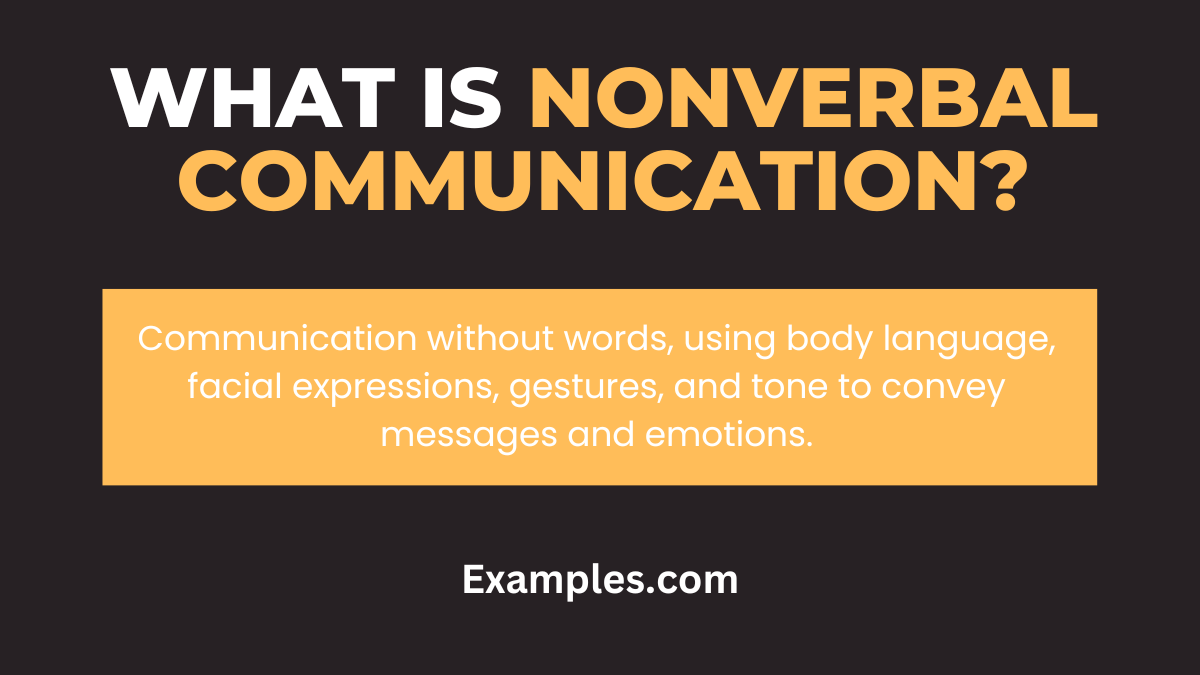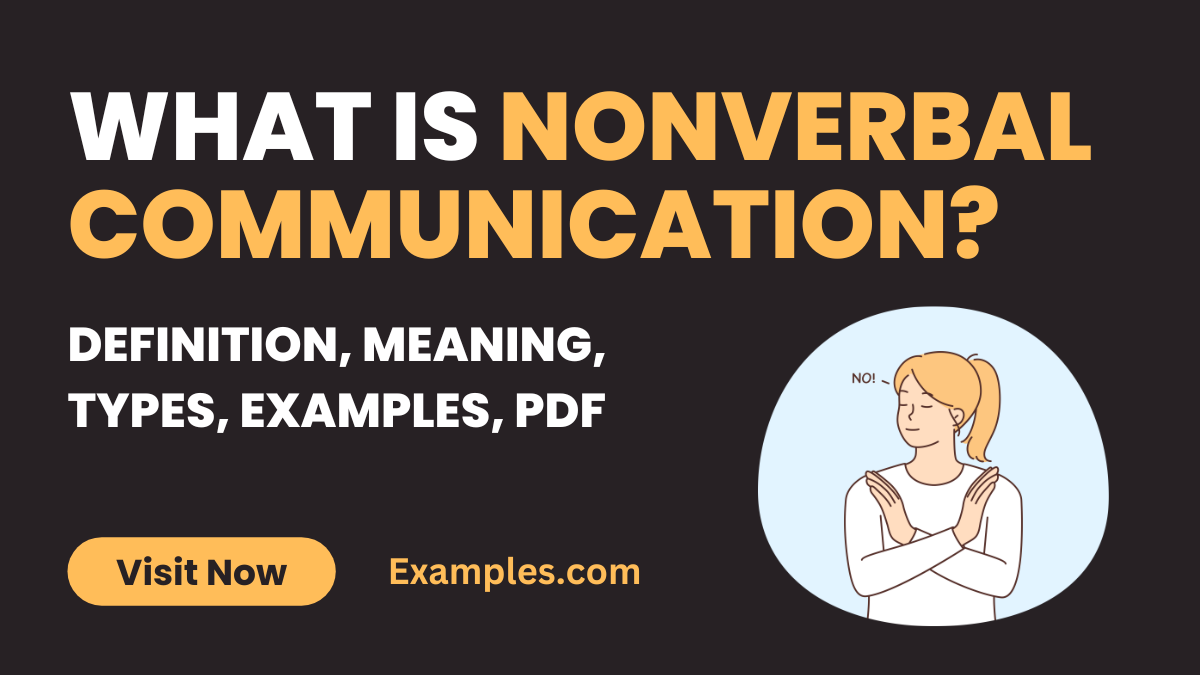What is Nonverbal Communication?
Nonverbal communication, often overshadowed in times of crisis communication, plays a pivotal role in conveying messages without words. This comprehensive guide explores the myriad forms of nonverbal cues – from facial expressions to body language – which make up a significant part of our daily interactions. Delve into the fascinating world of unspoken signals and learn how they can complement, contradict, or even replace verbal communication. Ideal for educators, students, and professionals, this guide offers insightful examples and practical tips to master the art of nonverbal communication.
What is Nonverbal Communication? – Definition

Nonverbal communication involves the transmission of messages or signals through a non-verbal platform such as eye contact, facial expressions, gestures, posture, and body language. It’s a silent form of communication that doesn’t involve words but conveys a lot of meaning.
Meaning
Nonverbal communication refers to the process of conveying a message without the use of spoken words. It encompasses a variety of silent signals, including body movements, facial expressions, and the physical distance between communicators. This form of communication relies on visual cues and body language to express feelings, intentions, and thoughts, often supplementing or even replacing verbal interactions.
Nonverbal Communication Examples
- Nodding During a Conversation: Indicates agreement or understanding.
- Crossed Arms: Can suggest defensiveness, discomfort, or resistance.
- Smiling: Conveys friendliness, happiness, or approval.
- Frowning or Furrowing Brows: Often shows confusion, disagreement, or concentration.
- Leaning Forward: Shows interest and engagement in the interaction.
- Avoiding Eye Contact: Might suggest discomfort, shyness, or deception.
- Hand Gestures While Speaking: Can emphasize points or express enthusiasm.
- Shaking Hands: A common greeting that can convey warmth and professionalism.
- Tapping Feet or Fidgeting: Indicates impatience, nervousness, or boredom.
- Personal Space: The distance maintained during communication can indicate the level of intimacy or comfort.
- Mirroring Body Language: Reflecting the gestures or posture of another person often signifies agreement or empathy.
- Raised Eyebrows: Can express surprise, skepticism, or interest.
- Tilting the Head: Often shows curiosity or contemplation.
- Steepling Fingers: Commonly seen as a gesture of confidence or authority.
- Sighing: Typically indicates frustration, exhaustion, or relief.
- Yawning: Often perceived as a sign of tiredness or boredom, but can also be a natural physiological response.
- Dressing Style: The way a person dresses can communicate various messages about their personality, status, or mood.
- Facial Flushing or Blushing: May indicate embarrassment, shyness, or excitement.
Types of Nonverbal Communication
Nonverbal communication is a broad field that includes various types. Some prominent types are:
- Facial Expressions in Nonverbal Communication
- Body Language in Nonverbal Communication
- Gestures in Nonverbal Communication
- Eye Contact in Nonverbal Communication
- Fidgeting in Body Language of Nonverbal Communication
- Touch / Haptics in Nonverbal Communication
- Nodding in Interactions for Nonverbal Communication
- Space (Proxemics) in Nonverbal Communication
- Physical Appearance in Nonverbal Communication
- Artifacts (Personal Objects) in Nonverbal Communication
- Paralanguage (Vocalics) in Nonverbal Communication
- Silence in Nonverbal Communication
- Time (Chronemics) in Nonverbal Communication
- Body Movements in Nonverbal Communication
- Body Postures in Nonverbal Communication
- Sign Language in Nonverbal Communication
- Adaptors in Nonverbal Communication
Functions of Nonverbal Communication
- Complementing in Nonverbal Communication
- Contradicting in Nonverbal Communication
- Accenting in Nonverbal Communication
- Repeating in Nonverbal Communication
- Regulating in Nonverbal Communication
- Substituting in Nonverbal Communication
What are the Skills of Nonverbal Communication?
The skills of nonverbal communication involve the ability to read and interpret body language, facial expressions, gestures, and other nonverbal cues. This includes understanding the subtleties of eye contact, posture, and spatial distance (proxemics). Effective nonverbal communicators are also adept at using their own body language to reinforce their message, creating consistency between their verbal and nonverbal cues. Developing these skills can lead to more effective and empathetic communication in various social and professional contexts.
What is Nonverbal Communication in Sociology
In sociology, nonverbal communication is studied as a means of understanding social interactions and the structure of societies. It plays a key role in conveying social norms, statuses, and roles within a community or culture. Sociologists examine how nonverbal cues like dress, gestures, and space usage vary across different cultures and social groups, influencing how individuals relate to each other. This aspect of communication is crucial in understanding the unspoken rules and dynamics that govern social interactions.
Non Verbal Communication at Workplace
Nonverbal communication at workplace is pivotal for effective interactions among colleagues. It encompasses various forms such as facial expressions, postures, gestures, and even dress code, which collectively contribute to the workplace environment. Effective nonverbal communication can lead to better teamwork, improved understanding, and stronger relationships among employees. It also plays a crucial role in leadership and management, as leaders’ nonverbal cues can greatly influence team morale and productivity. Understanding and appropriately utilizing nonverbal communication helps in building a positive and professional workplace culture.
What are the Importance of Nonverbal Communication?
The importance of nonverbal communication lies in its ability to add depth and context to verbal interactions. It helps in conveying emotions and intentions more effectively than words alone. Nonverbal cues, like body language and facial expressions, can reinforce or contradict what is being said, thus providing a clearer understanding of the message. This form of communication is crucial in building trust and rapport, as it often conveys sincerity and feelings more directly than verbal communication. In different social and cultural settings, nonverbal communication also plays a vital role in expressing respect and appropriate social behavior.
What are the Elements of Nonverbal Communication?
The elements of nonverbal communication include facial expressions, body movements and posture, gestures, eye contact, touch, space (proxemics), and paralanguage (vocalics). Facial expressions are perhaps the most expressive among these, conveying emotions like happiness, sadness, anger, or surprise. Body movements and posture can demonstrate confidence, interest, or boredom. Gestures like nodding or shaking the head add emphasis to verbal communication. Eye contact can establish rapport and show attentiveness. Touch, though varying in interpretation across cultures, can express support or solidarity. The use of space can indicate familiarity or authority. Lastly, paralanguage involves the tone, pitch, and volume of voice, adding emotional context to the spoken word.
Understanding nonverbal communication enhances interactions, bridging gaps where words fall short. While it offers advantages and Disadvantages like emotional expression and Cultural Differences, challenges like cultural differences and ambiguity persist. Implementing tips for effective nonverbal communication can mitigate these disadvantages, ensuring a more coherent and effective exchange of ideas and emotions in both personal and professional settings.



